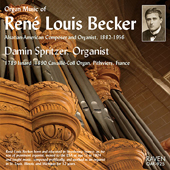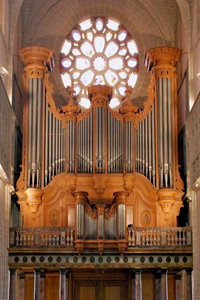
ESSENTIAL RECORDINGS


Step aside Léon Boëllmann, move over Charles-Marie Widor, and let René Louis Becker show you how it's done. I can't believe organ
music this good has been neglected or ignored by the recording industry for this long. This CD represents the world première recording of these pieces by
René Louis Becker (1882-1956). An Alsatian-American composer who was born in France, then moved to the United States in 1904 where he worked as an
organist for the rest of his life.
1- Sortie Solennelle, Op. 70
2- Cantilena, Op. 42
3- Toccata, Op. 45
4- Second Sonata in F, Op. 41
5- Third Sonata in E, Op. 43
6- Supplication, Op. 81a
7- Marche Triomphale: Ite missa est
This is colorful music, ripe with melodic invention, rich with harmonic confidence, and an effortless flair for thematic development that could put better known
composers to shame. The reason why I picked Boëllmann and Widor for comparison, is precisely because some of Becker's music very much resembles their style.
The Cantilena for example, brings to mind the Prière à Notre-Dame by Boëllmann, while the Toccata
has just as much forward momentum as the one made famous by Widor. The slower and more lyrical segments of his pieces are always adorned with
beautifully shaped melodies made to highlight the sweeter flute and oboe stops of the organ, while the more upbeat works will make you want to get up and walk a
victory march.
Unlike many other heavy-handed organists, Damin Spritzer drives the music along with plenty of forward momentum which adds a singing quality
to the melodic lines and an assured rhythmic movement to the toccatas and marches. Her constant search for unknown works for organ and championing of new works
by living composers, have brought much respect and many awards her way. The instrument she chose for this recording is the Organ of the Church of Saint-Salomon-
Saint-Grégoire in Pithiviers, France. It's a combination 1789 Isnard and 1890 Cavaillé-Coll, revised in 1960 by Robert Boisseau and fully restored in 2008 by Bertrand
Cattiaux. In fact, this recording is the first one since the restoration. It's a very well balanced instrument with a range of stops from a 2' Doublette to a 32' Soubasse, and
everything in between including some impressive Trumpet and Bombarde stops. Believe me, the final glorious chord of the Marche Triomphale will make you glad you're
alive.
Jean-Yves Duperron - June 2011